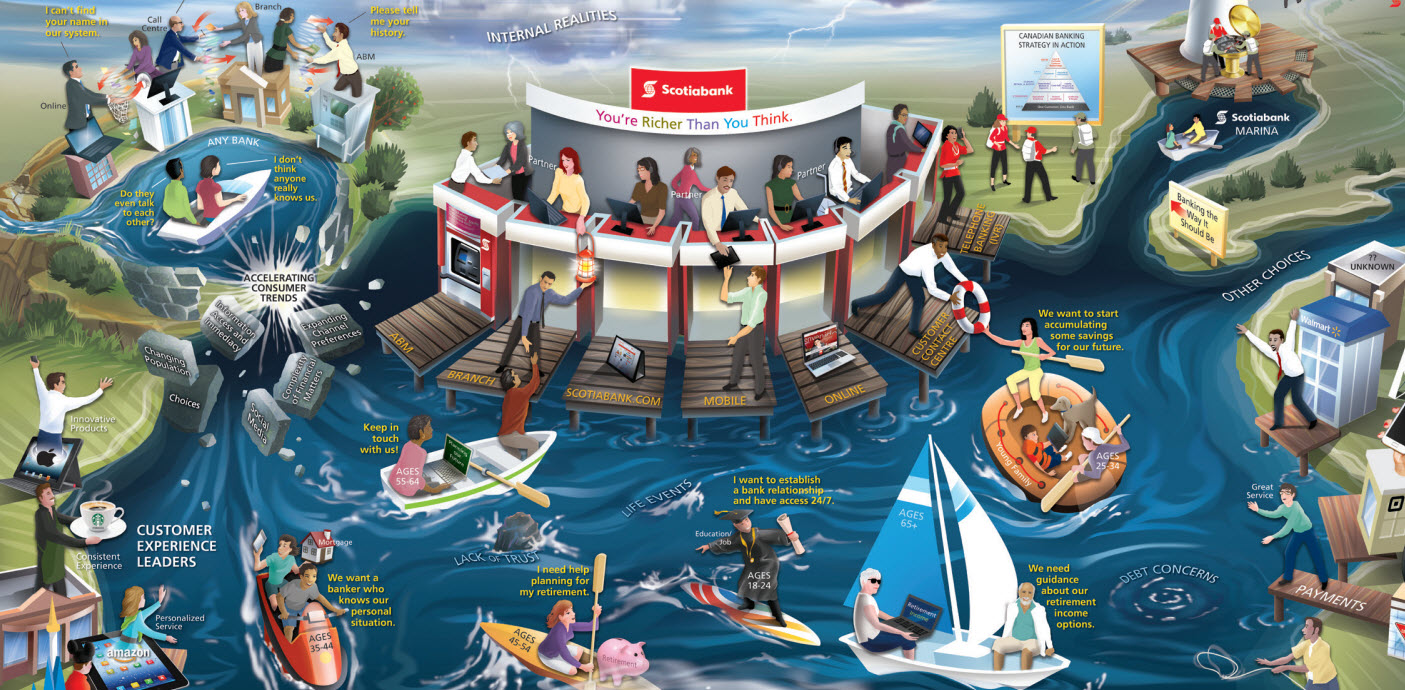
A revolutionary growth company with an innovative approach to strategic planning
It’s easy to talk about rapid growth. But growth requires effective execution, and execution starts first and foremost with people. Successful growth plans hit the sweet spot between two extremes. They make the strategic planning process a democracy where the conclusions merely represent what we can all agree on, or they represent a plan vetted by top executives (or worse yet, external consultants) behind boardroom walls. Traditional business planning methods often miss this sweet spot and sometimes extinguish the robust dialogue required to create a strategy that has the most essential ingredient – well-informed conviction.
Drop yourself into Proto Labs’ business planning process, which was almost entirely devoid of one-way PowerPoint presentations, and you would have found intense debate around visual sketches depicting its core growth challenges, cross-functional teams that included over 50 leaders collaborating to address those challenges, and creative pitches on what the business should look like in 2020. The result was an agile, multi-year business plan for Proto Labs with a much higher probability of success that has broad buy-in and conviction. And just as importantly, a community of 50+ Proto Labs leaders who built their individual and collective strategic thinking capabilities together.
Larry Lukis, a successful entrepreneur, product developer, and self-proclaimed computer geek, was floored by the time and money it took to get prototype and low-volume injection-molded parts. His answer was to develop a faster, less expensive, automated process for producing such parts. He founded the Protomold company in 1999. As Protomold added new capabilities, it changed its name to Proto Labs in 2009.
Since then, Proto Labs has grown into a global manufacturer, with production facilities in the United States, Europe, and Japan. It is the world’s fastest digital manufacturing source for custom prototypes and low-volume production parts. In February 2012, Proto Labs went public under the ticker symbol PRLB. By early 2013, the stock had tripled. By mid-2015, the company generated $233 million in trailing 12-month revenue, had 1,200 employees, and was valued at $1.8 billion.
Proto Labs has grown into a global manufacturer, with production facilities in the United States, Europe, and Japan. It is the world’s fastest digital manufacturing source for custom prototypes and low-volume production parts.
In 2014, Vicki Holt was named the CEO of Proto Labs, joining a thriving organizational culture with an impressive track record. However, she saw an opportunity to:
- Ask not just how much the company grew in the last year and what that means for the coming year, but also ask what’s the true market potential and what that means for the next three to five years.
- Develop a multi-year growth plan created by Proto Labs leadership and further build the capability of the organization and align leadership and team members to execute on the plan.
- Become a company that is four times its current size, help reinvent the industry, and, in turn, accelerate innovation globally.
The process to develop the multi-year growth plan was just as critical as the plan itself. The process and time commitment was an investment in Proto Labs’ leadership to build their individual and collective capabilities. Hiring a consultant to do the work wouldn’t work, so Holt turned to Root Inc., a partner she had worked with numerous times.
Most planning processes start with an articulation of the current state. Instead of defining the current state with a traditional SWOT analysis, Root developed a Watercooler® sketch, a visual depiction of the current state that covered the good, the bad, and the ugly.

The Watercooler® process is a humorous and visual method designed to capture the organization’s strategic and behavioral realities. It gives leaders permission and a platform to openly discuss the undiscussables, enabling leadership teams to step into the conflict that is critical for high performance.
“The Watercooler® process allowed us to get all of our strategic and cultural issues on the table, issues that are sometimes difficult to talk about or that go unsaid,” Holt said. “It was clear from the first meeting this process would be candid and authentic and that this session would set the tone for the rest of the process.”
Once the leadership team had established a shared perspective on the current realities facing the business, they focused their efforts on developing a common mental model of what winning would look like in the future. The leadership team divided into small groups for a workshop on the future state of Proto Labs. Team members were required to complete pie charts on the various sources of revenue and profit for the company and then pitch their story of what the business would look like by year-end 2017.
“In many planning processes, leaders iterate priorities but don’t take a step back to ask, ‘What will or should the business be like three to five years from now in look and feel, as well as in the numbers?’ This process quickly highlighted where we had a shared perspective on the future and where we had work to do,” said Bill Dietrick, vice president of global marketing.
Once the team established clarity on their desired future state, they worked to identify the organizational priorities to bridge the gap between the current and desired future states. With the input of 20+ leaders, Proto Labs identified 30 potential critical questions that could be addressed in the development of the multi-year growth strategy. Thirty questions were edited down to the four that needed to be addressed in the development of Proto Labs’ multi-year growth strategy. Teams for each of the questions were established, and over 50 Proto Labs employees were involved in the process to answer each of these questions and build an implementation plan.
“As the four workstream teams were coming together each month for collaborative review sessions, the energy and excitement in the organization was palpable. It was clear that the plan being developed was coming to life and being owned by a broader leadership team. We built capability, created a common language and alignment, and enhanced the camaraderie not only of today’s leadership team, but tomorrow’s leadership team too,” Dietrick said.
Finally, a traditional business plan represented by a 100+-page document with various exhibits was established and reviewed with the board; however, the PowerPoint presentation that often follows such a plan was substituted with a Root Strategic Learning Map® experience to engage people’s hearts and minds. All Proto Labs employees from various sites, functions, and levels came together in small groups to discuss the strategy for a few hours.
During the process, Holt publicly declared that Proto Labs was on its way to becoming a $1 billion company – a lofty goal for a $200 million organization. Today, not only do 1,200 employees believe it, but many of them have been a part of the journey, and the odds are now in their favor.
Strategic Learning Map® modules use illustrations, Socratic dialogue, and game-like exercises in small-group settings to engage large employee populations in the why, what, and how of the strategic direction.
“This planning process was a critical step in getting alignment as a senior leadership team on our vision and priorities to continue to drive rapid growth,” Holt said. “After the senior leadership team gained alignment, the process allowed us to engage the collective talent and knowledge of over 50 leaders in the company. Through this engagement we built strategic thinking skills, leadership skills, and commitment to the strategy. And finally, conducting the Strategic Learning Map® sessions with all our employees worldwide helped everyone understand our unique digital manufacturing business model, our sources of differentiation, where we are going, and most importantly, how each and every team member fits and contributes to the success of the strategy. That is the way to build a solid foundation for successfully executing a strategy!”

Disruptive Methods Applied























